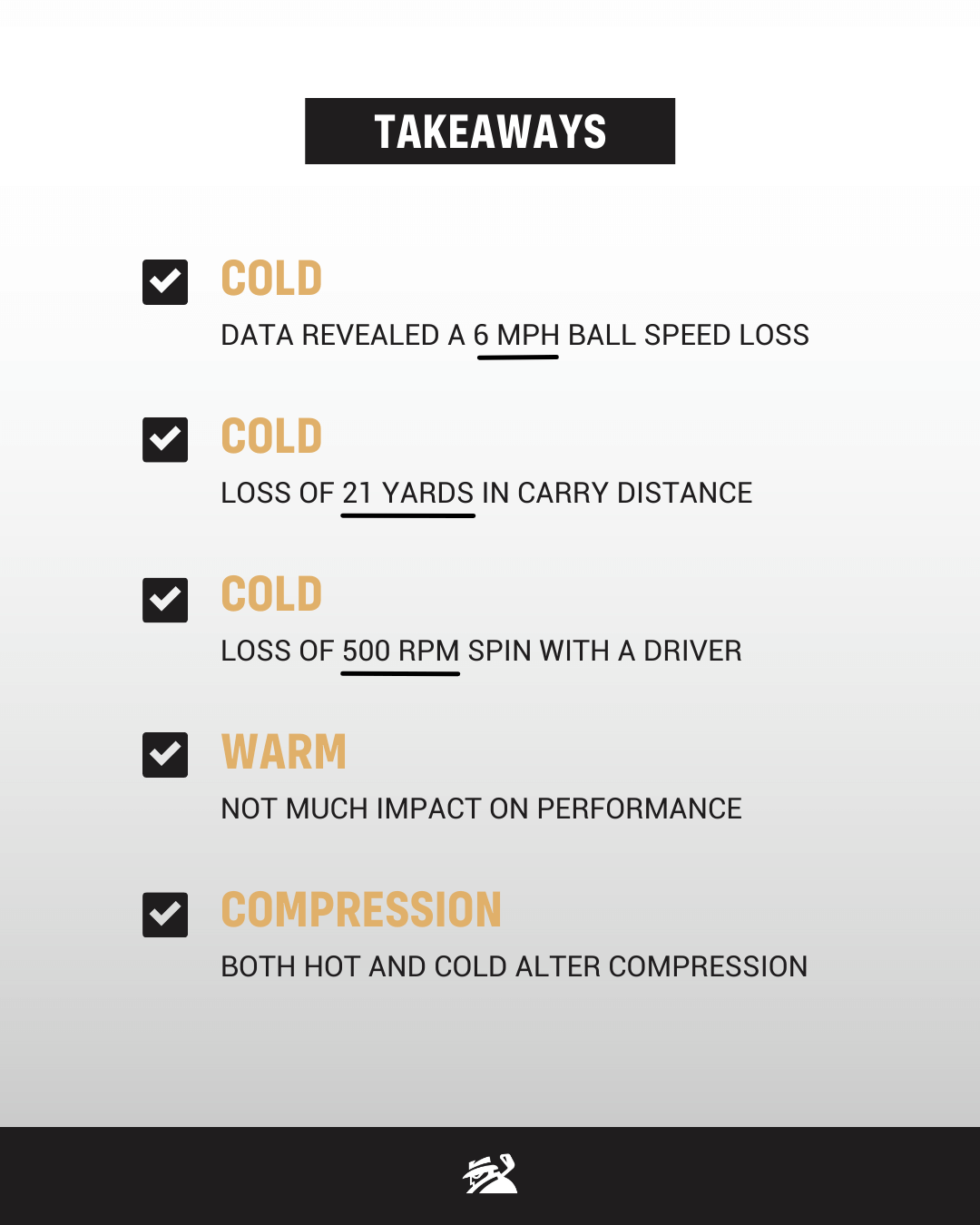On the last day of this year’s golf ball test, we had a little extra time to run a few smaller experiments. As a curiosity, we wanted to see how temperature changes can affect golf ball performance.
To see how an increase in temperature can impact performance, we left a portion of our test sample exposed to the Arizona heat.
To understand the impact of extreme cold on a golf ball, we stuck a portion of our sample in a freezer for the better part of a day.
We (well, the robot) hit both the hot and cold balls along with a sample of balls that had been kept inside, out of the sun and at room temperature. The test was conducted with a nine-degree driver and a swing speed of 100 mph.
As a follow-up to the preliminary data, we ran some tests inside the Ball Lab. We measured compression changes after placing balls under a 115-degree heat lamp for an hour and after six hours in a freezer.
Here’s what we found.
Key Takeaways
Warm Golf Balls
Exposure to golf balls in warm conditions does not significantly impact performance.
Cold Golf Balls
Prolonged exposure of golf balls to extreme cold conditions can significantly impact golf ball performance.
Compression
Exposure to both hot and cold temperatures can alter compression but it’s perhaps surprising that heat has a more significant impact on compression than extreme cold.
Warm Balls
We wanted to find out what impact leaving a ball to bake in the sun has on performance. Think of it as what might happen to your golf ball while it’s resting in the fairway while the group in front of you is putting on a slow-play exhibition.
While we can’t say the direct sunlight had no impact on performance, differences were certainly minimal enough that we can’t definitively say that heat alone was the cause.
As the chart above shows, ball speed was only slightly slower. The warmer balls spun a tick more on average and flew just a bit lower. The average carry difference was only one yard.
In the extreme, it’s likely that leaving your bag in the trunk of your car all day would have a greater impact. That’s based on what happened when we placed balls under a heat lamp.
As a follow-up, we did a quick experiment to quantify how much heat can change compression. We found that constant exposure to 115 degrees for one hour can decrease compression by more than 15 points.
When the heat source is removed, compression increases at a rate of one to two compression points every 10 minutes until it normalizes.
Given the compression changes observed by exposing golf balls to prolonged heat, unless your goal is to make a Titleist Pro V1x Left Dash feel a bit more like a Chrome Soft, we’d advise not storing balls in your car.
Frozen Balls
For this test, we placed golf balls in a freezer for about six hours.
Admittedly, this one was as much a curiosity as anything else. Since we were heating balls up a bit, it only made sense to cool them off as well.
For the SoCal and Sun Belt crowds, there’s probably not much in the way of practical value here but for those of us who sometimes tee off in sub-freezing temps, especially if you tend to leave your bag in the car, this test isn’t nearly as far-fetched as our warm-weather friends might think.
I’ve teed off with temps in the mid-20s and, while I probably won’t do it again, there’s zero chance I’m the only one who has ever layered up and tried to stretch out the golf season.
When hitting frozen balls, it’s fair to say the performance impact was more significant.
First, and perhaps most notably, was the significant difference in sound (and presumably feel). The frozen balls were loud and unpleasantly pitchy.
Observationally, the surface texture of the ball changes and likely firms up quite a bit. The working theory is that cold alters the material properties of the urethane covers, ultimately making them behave a bit like an extremely poor quality Surlyn.
Interestingly, the cold had only a minimal impact on compression. In our lab tests, after six hours in the freezer, compression only changes by two to three points.
As for the performance notes, the frozen balls launched lower and spun significantly more (nearly 500 rpm). Ball speeds dropped very significantly (more than six miles per hour on average). The flight was noticeably lower and, anecdotally, a bit erratic. Distance (both carry and total) dropped by more than 21 yards.
If you were thinking of freezing your balls to try and boost compression, speed, and distance, don’t.
The Takeaway
The initial results of our temperature experiments are interesting and there are definitely a number of rabbit holes we could dive into in pursuit of more insights.
For now, we’ll leave you with an understanding that temperature can impact golf ball performance but the degree to which it matters is dependent on the type and duration of exposure.
For the best (and most consistent) results, we’d advise against keeping your golf balls in your car. As with many things, room temperature is the sensible play.



















bob evans
12 months ago
exact golf had just opposite results, cold went further.